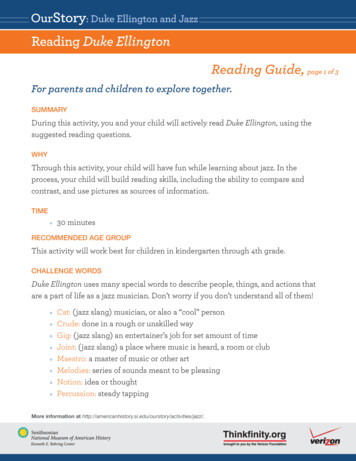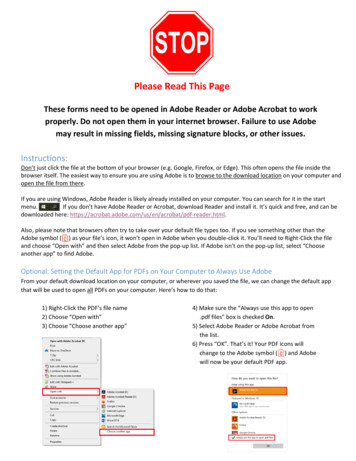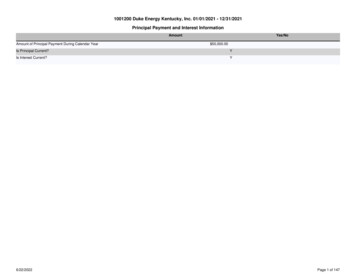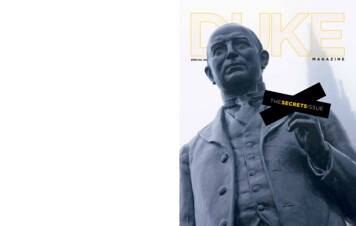
Transcription
OurStory: Duke Ellington and JazzReading Duke EllingtonReading Guide, page 1 of 3For parents and children to explore together.SUMMARYDuring this activity, you and your child will actively read Duke Ellington, using thesuggested reading questions.WHYThrough this activity, your child will have fun while learning about jazz. In theprocess, your child will build reading skills, including the ability to compare andcontrast, and use pictures as sources of information.TIME 30 minutesRECOMMENDED AGE GROUPThis activity will work best for children in kindergarten through 4th grade.CHALLENGE WORDSDuke Ellington uses many special words to describe people, things, and actions thatare a part of life as a jazz musician. Don’t worry if you don’t understand all of them! Cat: ( jazz slang) musician, or also a “cool” personCrude: done in a rough or unskilled wayGig: ( jazz slang) an entertainer’s job for set amount of timeJoint: ( jazz slang) a place where music is heard, a room or clubMaestro: a master of music or other artMelodies: series of sounds meant to be pleasingNotion: idea or thoughtPercussion: steady tappingMore information at jazz/.
OurStory: Duke Ellington and JazzReading Duke EllingtonReading Guide, page 2 of 3CHALLENGE WORDS (CONTINUED) Romp: rough and noisy playWail: make a sound like a sad cryPARENT PREPARATION If you have time, read the story yourself before sharing it with your child. Alsoread the Step Back in Time sheets and the notes on the last page of the book.If you have time, preview some of the reading suggestions below. Pick just afew suggestions that look interesting and fun for you.YOU NEED This reading guideStep Back in Time sheets (attached)Duke Ellington: The Piano Prince and His Orchestra book written by AndreaDavis Pinkney and illustrated by Brian PinkneyBEFORE YOU READ TipTo get a better sense of what jazz sounds like, consider listening to twoversions of “The Waltz of the Flowers” from the Nutcracker Suite. Theclassical version of the song, written by Peter Tchaikovsky, is on this pagefrom the International Music Score Library Project http://imslp.org/wiki/TheNutcracker %28suite%29, Op.71a %28Tchaikovsky, Pyotr%29 . A jazzversion, written by Duke Ellington, is on this page from audio pointer files/zz danceofthef.wvx.Keep in mind the differences in these two styles of music as you read.You only need to listen to a minute or two of each recording to hear thedifference.More information at jazz/.
OurStory: Duke Ellington and JazzReading Duke EllingtonReading Guide, page 3 of 3DURING READING Tip As you read, listen for ways that the author stretches the normal rules ofwriting to tell her story.For example, the first line of the story doesn’t follow the rules of writing,but it makes a fun rhythm to say out loud. If the sentence followed therules, it might sound like “Have you ever heard of the jazz playing man?He was a man with a band of cats who could swing.”As you read, listen for new words or words that seem to have new meanings inthis story. Some of the words are defined in the Challenge Words section, socheck there first if you get stuck. Some of the words are old fashioned wordswe no longer use very often, others are part of the culture shared by jazzmusicians.AFTER READING TipTake another look at all the instruments described in the book. Think of a fewthings that help you remember what each kind of instrument looks like. Thengo through the book again to name the instruments in each picture.For extra challenge, try to guess what instruments are in the cases on thepicture where Duke Ellington’s Orchestra is boarding a train.Did your eagle eyes spot instruments that aren’t described much in thebook? One you might have noticed is the u/resource/?key 1507), whichwas popular in early jazz, but not as common for jazz music today. Talk about what kind of music your family likes to listen to. Do you have afavorite song? What is the story behind that song?More information at jazz/.
OurStory: Duke Ellington and JazzReading Duke EllingtonStep Back in Time, page 1 of 2For more information, visit the National Museum of American History Web ies/jazz/.JAZZ HISTORYSome people consider jazz as “America’s classical music.” Jazz was born in NewOrleans, Louisiana, during the early 1900s when musicians mixed ragtime,marches, blues, and African American musical traditions. At first jazz was mostly fordancing, but it soon became just as enjoyed for listening.After the first recordings of jazz were made in 1917, the music spread widely anddeveloped quickly. The growth of jazz was led by brilliant musicians such as LouisArmstrong, Duke Ellington, Charlie Parker, and Miles Davis, who helped define newstyles of jazz, like swing and bebop. At the same time, jazz spread from the UnitedStates to many countries, and today jazz can be heard around the globe.JAZZ MUSICThere is a lot of variety in jazz, but most jazz isvery syncopated, has a forward-moving energycalled “swing,” and uses “bent” or “blue” notes.“Mood Indigo” sheet musiccomposed by Barney Bigardand Duke Ellington. DukeEllington Collection, NationalMuseum of American HistoryYou might listen to a dozen different jazz recordingsof the same song, but each will sound different. Inmost jazz performances, individuals play solos, whichthey improvise. Jazz artists—both vocalists andinstrumentalists—also like to perform their music intheir own personal styles.
OurStory: Duke Ellington and JazzReading Duke EllingtonStep Back in Time,page 2 of 2DUKE ELLINGTONEdward Kennedy “Duke” Ellington(1899–1974) was an expert in exploring hismusical imagination. Duke paid attention tonew musical forms and used the instruments inhis band to create his own style of jazz. As youlisten to Duke’s music, pay close attention tosome of his signature sounds, such as mutedtrumpets, high clarinet notes, his unique pianoplaying, and unusual combinations ofinstruments. Because of his skills in writingsong, leading his band, and performing music,some experts think Duke is America's greatestall-around musician.Duke Ellington, a native of Washington,D.C., in the 1930s. Duke EllingtonCollection, National Museum of AmericanHistory Archives Center.For more information, visit the Duke Ellington andBilly Strayhorn: Jazz Composers online exhibition xhibitions/ellington strayhorn 1.html.Improvise: make up on the spotMusical forms: the overall plans for pieces of music, such as when verses are repeated in songsSyncopated: rhythm that includes an accent on a normally weak beat in music
OurStory: Duke Ellington and JazzReading Duke EllingtonFor TeachersRead the “Reading Guide” sheets for specific reading tips.OBJECTIVESThe students will be better able to: Read for understanding.Answer questions using written and pictorial resources.STUDENT PERFORMANCE CRITERIA Discussion exhibits understanding of story and historical details.Discussion exhibits logical connections and comparisons.STANDARDSNCHS History StandardsK-4 Historical Thinking Standards3F. Analyze illustrations in historical stories.K-4 Historical Content Standards1B. The student understands the different ways people of diverse racial, religious, andethnic groups, and of various national origins, have transmitted their beliefs andvalues.IRA/NCTE Language Arts Standards1.Students read a wide range of print and nonprint texts to build an understanding oftexts, of themselves, and of the cultures of the United States and the world; toacquire new information; to respond to the needs and demands of society and theworkplace; and for personal fulfillment. Among these texts are fiction andnonfiction, classic and contemporary works.3.Students apply a wide range of strategies to comprehend, interpret, evaluate, andappreciate texts. They draw on their prior experience, their interactions with otherreaders and writers, their knowledge of word meaning and of other texts, their wordidentification strategies, and their understanding of textual features (e.g.,sound-letter correspondence, sentence structure, context, graphics).More information at jazz/.
OurStory: Duke Ellington and Jazz Reading Duke Ellington CHALLENGE WORDS (CONTINUED) Romp: rough and noisy play Wail: make a sound like a sad cry PARENT PREPARATION If you have time, read the story yourself before sharing it with your child. Also read the Step Back in Time sheets and the notes on the last page of the book.










